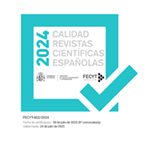The interactional construction of (dis)information: from the live television political interview to the newspapers
Abstract
With the aim to extent the knowledge about how journalistic disinformation operates, a case of disinformation that goes through television and press is studied. Applying Conversation Analysis’ theory and methods, this research focuses on the live television political interview (EPTV) that produced the disinformation that, afterwards, was widespread by the newspapers. From an interactional perspective, this research accounts what occurred in the EPTV, identifying conversational practices that lead to the production of disinformation, with particular emphasis on journalistic practices. For their part, the newspapers show, in an indirect way, the disinformation repercussions on the audience, through how diverse media, with different ideological affinities (left, right), received, understood, and, disseminated the disinformation produced by the EPTV. Theoretical and practical implications are identified. Among them, highlight that the interviewer (PHE) asks the interviewee (PE) about vicarious experiences that the PE has no way of giving an account, as well as the PHE becomes coauthor of the answers to her own questions. In addition, the PHE resort to conversational practices that are characteristic of gossip and alien to the institutional talk that (normatively) characterizes EPTV.
Downloads
Article download
License
In order to support the global exchange of knowledge, the journal Estudios sobre el Mensaje Periodístico is allowing unrestricted access to its content as from its publication in this electronic edition, and as such it is an open-access journal. The originals published in this journal are the property of the Complutense University of Madrid and any reproduction thereof in full or in part must cite the source. All content is distributed under a Creative Commons Attribution 4.0 use and distribution licence (CC BY 4.0). This circumstance must be expressly stated in these terms where necessary. You can view the summary and the complete legal text of the licence.










